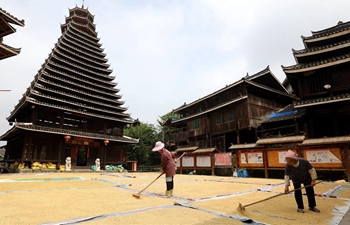LANZHOU, Sept. 13 (Xinhua) -- More than 2,000 years ago, camel caravans had traversed the dry sands along the ancient Silk Road exchanging goods between the East and the West. Today, riding a camel in the desert is a popular activity for visitors during their modern Silk Road journeys.
As a major stop on the ancient Silk Road, the oasis city Dunhuang of Gansu Province, northwest China, has witnessed the vicissitudes of the times, and the camel riding business is providing a lucrative outlet for the locals.
The city is best known for the nearby Mogao Grottoes, and home to Crescent Lake and Singing-sand Mountain. Since the Belt and Road Initiative was put forward five years ago, the city has thrived on tourism and camels are a vital part of the booming tourist industry.
Kang Qiang lives in the Yueyaquan Village near the scenic area. These years, farmers like him not only see the increasing popularity of their hometown but also benefit from it.
In the late 1990s, the local government took the lead in managing the camel riding service by introducing a quota system. Each household could have up to four camels. Moreover, the quota can be traded among the households in the village.
Since then, more villagers were encouraged to partake in the business, but the real surge came in recent years. During the peak season in September this year, Kang said he could walk with his camels at most 30 kilometers each day in the desert.
"I have to ensure my camels get enough rest," said Kang, "it's very hard to accommodate the strong demands of the tourists."
According to local authorities, Dunhuang received over 9 million visitors in 2017, with a year-on-year increase of 12.3 percent. Back in 1988, the number was 300,000.
"In 1988, Yueyaquan Village had nearly 100 camels from 250 households, but the number rose to 1,600 from 264 households in 2017, a tenfold increase," said Jia Zhiqiang, a member of the villagers' committee.
The Belt and Road Initiative has attracted more foreign visitors to the ancient city. "An overwhelming majority of tourists from abroad have added camel riding to their to-do list when they come to Dunhuang," Kang said.
Due to frequent contact with foreign visitors, Kang who knew nothing of foreign languages has learned a few English and Japanese words. The stable camel business helps Kang and his neighbors bring in more income compared to farming.
"My camels and farmhouse inn can bring me an annual income of 300,000 yuan (43,700 U.S. dollars), well above the average of my peers in the village," said Kang. He has more than 10 camels, over half of which are contracted from other villagers. Now, he lives in a spacious downtown apartment and drives a sedan worth more than 100,000 yuan.
Kang brings two different camels to the scenic area each day based on a schedule to ensure their health and well-being. He also pays extra attention to their food sources especially during the peak season.
For 43-year-old Jia, he also takes good care of his camels. "In the 1980s, camels were mostly used for agricultural purposes in our village," Jia recalled, "but a few of the camels also provided riding services for Japanese tourists."
Propelled by the Belt and Road Initiative, Dunhuang is becoming one of the big names among the tourist destinations in China. In addition to visitors from Japan and the Republic of Korea, more and more tourists are coming from the United States, Italy, France, the United Kingdom, and African countries to visit Dunhuang.
With the influx of tourists comes an influx of cash. Based on the data released by the local government, the per capita net income of farmers in Yueyaquan Village in 2017 reached 15,000 yuan (2,183 U.S. dollars), among the highest income group of residents in Dunhuang.
Since 2014, villagers have also diversified their services to meet the growing travel demand by opening farmhouse inns. These days, over 60 percent of the households in the village work in tourism-related businesses.

















